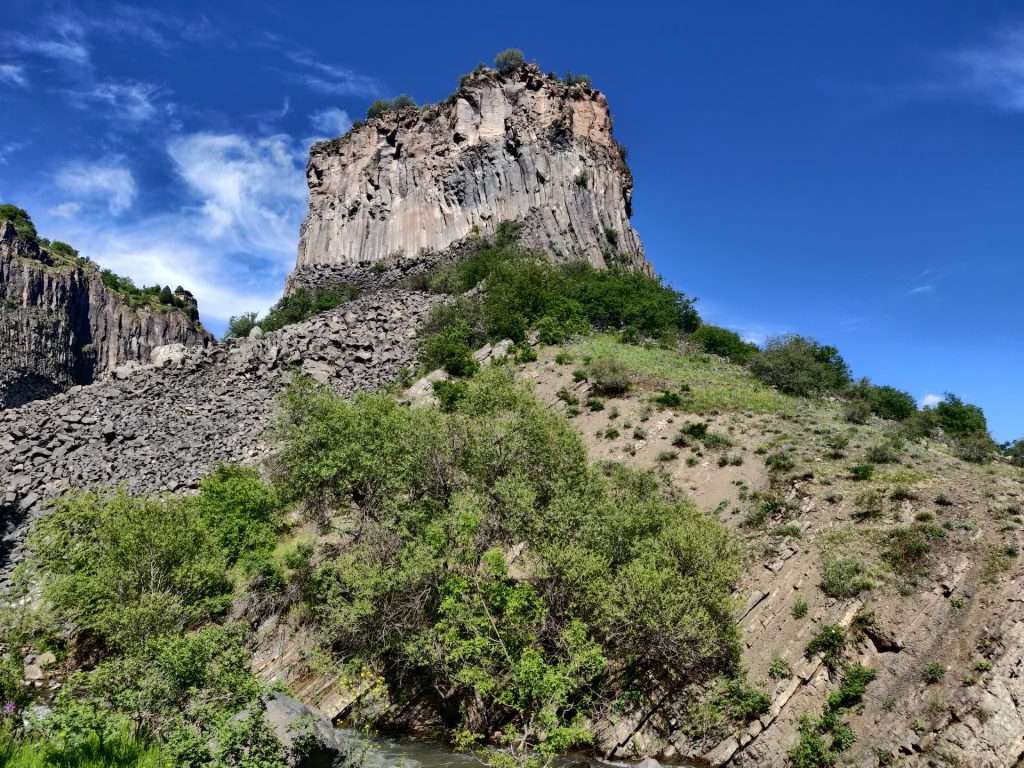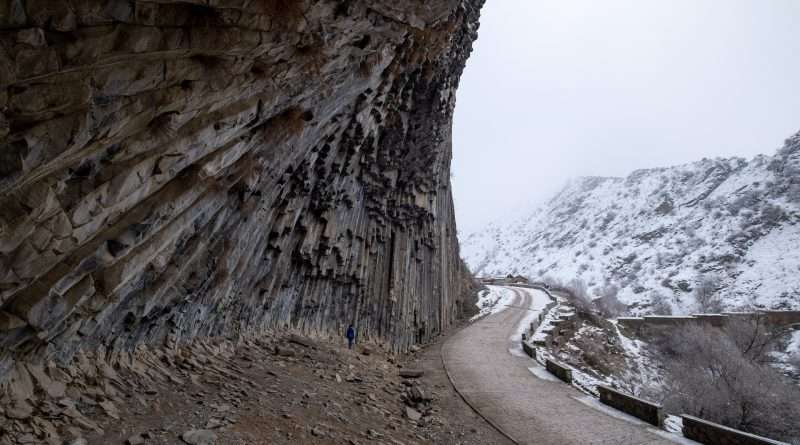Garni Gorge: Armenia’s Basalt Canyon
Garni Gorge is a protected natural monument near Garni village, ~19 miles (≈30 kilometers) east of Yerevan. Its cliff walls display striking hexagonal and pentagonal basalt columns up to ~165 feet (≈50 meters) tall, formed as a Gegham Highlands lava flow cooled. The site—known locally as “Քարերի սիմֆոնիա” (Symphony of Stones)—sits beneath the Temple of Garni.
Orientation & Quick Facts
Where: Garni Gorge lies just below Garni village in Kotayk Province, on the Azat River’s canyon, about 14–15 miles (23–24 kilometers) from Yerevan as the crow flies and around 19 miles (≈30 kilometers) by road. Precise coordinates often used for the basalt wall are around 40°07′06″N, 44°43′14″E.
Protection: The “Symphony of Stones / Basalt Organ” sector is listed in Armenia’s official natural monuments register (Gov. Decision No. 967-N, 14 Aug 2008), which anchors its conservation status in law. Armenian sources and signage also reference code KT-GE037 for the monument.
UNESCO status (2025): In 2025, Armenia added “The Archaeological Complex of Garni and the ‘Basalt Organ’ Columnar Joint” to UNESCO’s Tentative List—a first formal step toward World Heritage nomination that binds the cultural (temple–fortress) and geological (columnar jointing) assets into one story.
Local names you’ll hear
Armenians commonly say Քարերի սիմֆոնիա (Qareri Simfonia, “Symphony of Stones”) or Բազալտե երգեհոն (“Basalt Organ”). The gorge itself is referred to as Գառնու ձոր (Garni Gorge) and also as part of the Ազատի կիրճ (Azat Canyon), reflecting the river corridor. You’ll see both in Armenian-language materials and on local maps.
| Metric / Fact | Value (imperial • metric) |
|---|---|
| Distance from Yerevan (road) | ~19 mi • ≈30 km |
| Column height (max) | up to ~165 ft • ≈50 m |
| Lava flow age (40Ar/39Ar) | ~127,000 years (Late Pleistocene) |
| Coordinates (approx.) | 40°07′06″N, 44°43′14″E |
| Legal status | State natural monument (Gov. 967-N, 2008) |
| UNESCO step | 2025 Tentative List (mixed site) |
How Garni Gorge Formed

Garni’s walls expose a lava flow that spilled from vents on the Gegham volcanic upland and cooled slowly. As it contracted, the rock fractured into long, tightly packed columns—most with five or six sides—before the Azat River cut down through the flow, revealing today’s cliff face. The Gegham volcanic ridge itself hosts over a hundred Pleistocene–Holocene centers, the source terrain for flows like Garni.
Armenian and international field guides for volcanologists cite a ~127 ka (thousand years) 40Ar/39Ar age for this lava. UNESCO’s Tentative List entry highlights how ~60 meters (≈197 feet) of canyon incision since that eruption implies a long-term erosion pace of roughly 0.47 m per thousand years—a clear, numbers-based snapshot of how fast rivers reshape a young volcanic landscape.
Columnar jointing—kid-simple
Imagine baking a thick pan of brownies and letting it cool. As the brownie slab shrinks, it cracks into neat pieces. Basalt does something similar. When thick lava cools evenly from top and bottom, it cracks in a honeycomb pattern, making columns that look like giant stone straws. In Garni, many of those “straws” extend for tens of meters and hang like a frozen pipe organ.
Culture on the Rim: Temple, Bridge & Monastery
Temple of Garni: Perched on the canyon edge is Armenia’s only standing Greco-Roman style temple (Ionic order), a 1st-century symbol of pre-Christian Armenia. It crowns the basalt plateau directly above the columns and frames the classic photo: antique architecture over a volcanic “organ.”
Medieval Bridge of Garni: Down in the gorge, the 11th-century single-arch stone bridge across the Azat was reinforced/restored in a program supported by the U.S. Ambassador’s Fund for Cultural Preservation (AFCP) beginning in 2011 (≈$110,000). Works proceeded in 2012, and local media tracked the reopening timeline. That effort stabilized a key crossing and signaled growing care for the heritage corridor.
Havuts Tar & Khosrov Reserve: Across the gorge, the ruins of Havuts Tar (11th–13th c.) sit inside the strictly protected Khosrov Forest State Reserve—one of the world’s oldest protected areas. Entry to some hiking routes requires advance registration and a permit; recent hikers report a ~3,000 AMD fee for the route to Havuts Tar from the Garni side (policies can change: check official notices).
How to Visit Garni Gorge (Practical Guide)
By public transport: Frequent minibuses (marshrutkas) run from Yerevan’s Gai bus station to Garni and onward to Goght. Routes commonly cited include #266 and #284; fares are typically 250–500 AMD (about a dollar), with ~50–60 minutes transit time. Check Transport for Armenia for current timetables and the 284 line page (Gai → Goght), and allow for seasonal changes.
On foot: From the Temple of Garni, a cobbled road drops to the river and turns right to the main “Symphony of Stones” wall and the medieval bridge. HIKEArmenia’s “Temple of the Sun”/Azat Gorge route outlines a popular descent and onward walk toward Azat Reservoir, with additional variants on AllTrails/Wikiloc.
Tickets & small fees: The gorge itself is a natural monument; access is usually free, but travelers periodically report a small, local ticket or parking fee near the “Symphony of Stones” entrance (≈250–500 AMD). Treat this as variable and bring small cash.
Best seasons: Late April–November offers dry paths and warm light; winter reveals an “icefall” spectacle in the Azat canyon on cold snaps, but footing can be icy. Dress for wind on the rim and cooler air on the riverbed.
Safety & etiquette: Watch for falling-rock signs and avoid clustering under overhangs. Do not pry stones from the columns (there have been past incidents of damage and illegal extraction flagged by local media and activists). Stay off reserve zones that require permits unless registered.
Trail pointers
Waymarks and boards around the temple and village point you down to the river; after the main wall, the rightward track reaches the bridge; the leftward riverside route meanders toward the Khosrov Reserve gate and, with permit, to Havuts Tar. HIKEArmenia’s map is a reliable, locally maintained reference for distances and exit options.
Global Context: Why Garni Stands Out
Textbook basalt columns appear worldwide—from Northern Ireland’s Giant’s Causeway to Iceland’s waterfall amphitheaters—but Garni’s combination of youthful lava age, dramatic vertical exposure, and immediate cultural skyline (a classical temple above, a medieval bridge below) is rare. The site also sits on Armenia’s just-launched UNESCO Tentative List entry that explicitly binds archaeology and geology into a single “mixed” story, signaling global significance.
Scientifically, Garni is a field-ready outcrop tying the Gegham volcanic field’s late Pleistocene pulses to measurable canyon incision rates—data points that appear in Armenian volcanology excursions and international summaries. For travelers, that science turns into an easy day hike where numbers (127 ka, 60 m incision) animate the landscape in front of you.
FAQ
Is Garni Gorge part of the Azat River or the Goght River system?
The landscape here is often called both “Garni Gorge” and “Azat Canyon.” UNESCO’s 2025 Tentative List entry frames the basalt organ within the Azat River canyon; local pages also note the Goght tributary nearby—both shape the area around Garni.
How tall are the columns, and are they really natural?
Yes—this is classic columnar jointing. Columns in the signature wall rise up to about 165 feet (≈50 meters). Their near-perfect hexagons and pentagons come from slow, even cooling of thick basalt—no masonry involved.
Do I need a permit to hike beyond the gorge?
Not for the gorge itself. But if you continue to Havuts Tar and deeper into Khosrov Forest State Reserve, routes require prior registration and a permit; hikers recently reported about 3,000 AMD for the Havuts Tar trail. Always check the Environment Ministry’s current guidance before you go.
What Did We Learn Today?
- Garni Gorge’s columns formed from a Gegham upland lava flow ~127,000 years ago; the Azat River has carved ~197 feet (≈60 meters) since then.
- The site is a state-listed natural monument (Gov. 967-N) and since 2025 is on UNESCO’s Tentative List with the Temple of Garni.
- Columns reach ~165 ft (≈50 m) and are locally called “Symphony of Stones” / “Basalt Organ.”
- Practical access is easy: minibuses #266/#284 from Yerevan’s Gai station; expect ~50–60 minutes and a low fare.
- Culture frames the canyon: a 1st-century temple above and a U.S.-backed restoration of the medieval bridge below.

